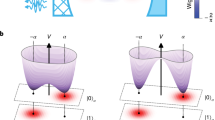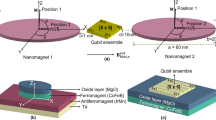Abstract
The Parametron was first proposed as a logic-processing system almost 50 years ago1. In this approach the two stable phases of an excited harmonic oscillator provide the basis for logic operations2,3,4,5,6. Computer architectures based on LC oscillators were developed for this approach, but high power consumption and difficulties with integration meant that the Parametron was rendered obsolete by the transistor. Here we propose an approach to mechanical logic based on nanoelectromechanical systems7,8,9 that is a variation on the Parametron architecture and, as a first step towards a possible nanomechanical computer10,11,12, we demonstrate both bit storage and bit flip operations.
This is a preview of subscription content, access via your institution
Access options
Subscribe to this journal
Receive 12 print issues and online access
$259.00 per year
only $21.58 per issue
Buy this article
- Purchase on Springer Link
- Instant access to full article PDF
Prices may be subject to local taxes which are calculated during checkout



Similar content being viewed by others
References
Goto, E. The parametron, a digital computing element which utilises parametric oscillation. Proc. IRE 47, 1304–1316 (1959).
Van den Broeck, C. & Bena, I. Stochastic Processes in Physics, Chemistry and Biology (Springer-Verlag, Berlin, 2000).
Hayashi, C. Nonlinear Oscillations in Physical Systems (Princeton Univ. Press, 1986).
Sanmartin, J. R. O Botafumeiro: Parametric pumping in the middle ages. Am. J. Phys, 52, 937–945 (1984).
Rugar, D. & Grütter, P. Mechanical parametric amplification and thermomechanical noise squeezing. Phys. Rev. Lett. 67, 699–702 (1991).
Turner, K. L. et al. Five parametric resonances in a microelectromechanical system. Nature 396, 149–152 (1998).
Roukes, M. Nanoelectromechanical systems face the future. Phys. World 14, 25–31 (February 2001).
Roukes, M. L. Mechanical computation, redux? IEEE IEDM Technical Digest 539–542 (2004).
Ekinci, K. L. & Roukes, M. L. Nanoelectromechanical systems. Rev. Sci. Instrum. 76, 061101 (2005).
Masmanidis, S. C. et al. Multifunctional nanomechanical systems via tunably coupled piezoelectric actuation. Science 317, 780–783 (2007).
Badzey, R. L. & Mohanty, P. Coherent signal amplification in bistable nanomechanical oscillators by stochastic resonance. Nature 437, 995–998 (2005).
Blick, R. H., Qin, H., Kim, H-S. & Marsland, R. A nanomechanical computer—exploring new avenues of computing. New J. Phys. 9, 241 (2007).
Kraus, A. et al. Parametric frequency tuning of phase-locked nanoelectromechanical resonators. Appl. Phys. Lett. 79, 3521–3523 (2001).
Naik, A. et al. Cooling a nanomechanical resonator with quantum back-action. Nature 443, 193–196 (2006).
Cleland, A. N. & Roukes, M. L. A nanometre-scale mechanical electrometer. Nature 392, 160–162 (1998).
Badzey, R. L., Zolfagharkhani, G., Gaidarzhy, A. & Mohanty, P. A controllable nanomechanical memory element. Appl. Phys. Lett. 85, 3587–3589 (2004).
Rueckes, T. et al. Carbon nanotube-based nonvolatile random access memory for molecular computing. Science 289, 94–97 (2000).
Jang, J. E. et al. Nanoscale memory cell based on a nanoelectromechanical switched capacitor. Nature Nanotech. 3, 26–30 (2008).
Carr, S. M., Lawrence, W. E. & Wybourne, M. N. Buckling cascade of free-standing mesoscopic beams. Europhys. Lett. 69, 952–958 (2005).
Huang, X. M. H., Zorman, C. A., Mehregany, M. & Roukes, M. L. Nanodevice motion at microwave frequencies. Nature 421, 496 (2003).
Sazonova, V. et al. A tunable carbon nanotube electromechanical oscillator. Nature 431, 284–287 (2004).
Acknowledgements
The authors are grateful to S. Miyashita for growing the heterostructure. The authors thank K. Takashina, M. Pioro-Ladrière, N. Lambert, P. Giudici, S. Camou and Y. Hirayama for useful discussions and advice. This work was partly supported by the Japan Society for the Promotion of Science (JSPS) KAKENHI(16206003).
Author information
Authors and Affiliations
Corresponding authors
Supplementary information
Rights and permissions
About this article
Cite this article
Mahboob, I., Yamaguchi, H. Bit storage and bit flip operations in an electromechanical oscillator. Nature Nanotech 3, 275–279 (2008). https://doi.org/10.1038/nnano.2008.84
Received:
Accepted:
Published:
Issue Date:
DOI: https://doi.org/10.1038/nnano.2008.84
This article is cited by
-
An interconnect-free micro-electromechanical 7-bit arithmetic device for multi-operand programmable computing
Microsystems & Nanoengineering (2023)
-
Dynamical response and noise limit of a parametrically pumped microcantilever sensor in a Phase-Locked Loop
Scientific Reports (2023)
-
Creating electronic oscillator-based Ising machines without external injection locking
Scientific Reports (2022)
-
Nanomechanical probing and strain tuning of the Curie temperature in suspended Cr2Ge2Te6-based heterostructures
npj 2D Materials and Applications (2022)
-
Mechanical memory operations in piezotransistive GaN microcantilevers using Au nanoparticle-enhanced photoacoustic excitation
Microsystems & Nanoengineering (2022)



